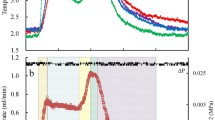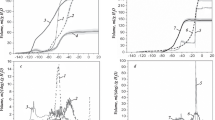Abstract
The specific surface area of methane hydrates, formed both in the presence and absence of sodium dodecyl sulfate (SDS) and processed in different manners (stirring, compacting, holding the hydrates at the formation conditions for different periods of time, cooling the hydrates for different periods of time before depressurizing them), was measured under atmospheric pressure and temperatures below ice point. It was found that the specific surface area of hydrate increased with the decreasing temperature. The methane hydrate in the presence of SDS was shown to be of bigger specific surface areas than pure methane hydrates. The experimental results further demonstrated that the manners of forming and processing hydrates affected the specific surface area of hydrate samples. Stirring or compacting made the hydrate become finer and led to a bigger specific surface area.
Similar content being viewed by others
References
Claussen W F. A second water structure for inert gas hydrates. J Chem Phys, 1951, 19: 1425–1432
von Stackelberg M, Müller H R. Feste Gas Hydrate II. Z Elektrochem, 1954, 58: 25–31
Jeffery G A, McMullan R K. The clathrate hydrates. Prog Inorg Chem, 1967, 8: 45–51
Ripmeester J A, Ratcliffe C I, Tse J S. The nuclear magnetic resonance of 129Xe trapped in clathrates and some other solids. J Chem Soc, 1998, 84: 3731–3738
Kvenvolden K. Gas hydrates-geological perspective and global change. Rev Geophys, 1993, 31: 173–187
Sloan E D. Clathrate Hydrates of Natural Gases. 2nd ed. New York: Marcel Dekker, 1998, 19–23
Ballard A L, Sloan E D. Hydrate separation process for close-boiling compounds. Proceedings of 4th International Conference on Gas Hydrates, Yokohama, 2002. 1007–1011
Kang S P, Lee H, Lee C S, Sung W M. Hydrate phase equilibria of the guest mixtures containing CO2, N2 and tetrahydrofuran. Fluid Phase Equilib, 2001, 185: 101–109
Zhang L W, Chen G J, Sun C Y, Fan S S, Ding Y M, Wang X L, Yang L Y. The partition coefficients of ethylene between hydrate and vapor for methane+ethylene+water and methane+ethylene+SDS+water systems. Chem Eng Sci, 2005, 60: 5356–5362
Gudmundsson J S, Khokha A A, Parlaktuna M. Storage of natural gas as frozen hydrate. Proceedings of 67th Annual Technical Conference and Exhibition of SPE, SPE24924, 1990. 699–707
Ershov E D, Yakushev V S. Experimental research on gas hydrate decomposition in frozen rocks. Cold Reg Sci Tech, 1992, 20: 147–156
Stern L A, Susan C, Stephen H K. Anomalous preservation of pure methane hydrate at 1 atm. Phys Chem B, 2001, 105: 1756–1762
Shirota H, Aya I, Namie S. Measurement of methane hydrate dissociation for application to natrural gas storage and transporation. Proceedings of the 4th International Conference on Gas Hydrates, Yokohama, 2002. 972–977
Shirota H, Aya I, Namie S. Measurement of methane hydrate dissociation for application to natural gas storage and transportation. Proceedings of 4th International Conference on Gas Hydrates, Yokohama, 2002. 972–976
Zhou L, Sun Y, Zhou Y. Enhancement of the methane storage on wet activated carbon by preadsorbed water. AIChE J, 2002, 48: 2412–2416
Rogers R E, Zhong Y, Etheridge J A, Arunkumar R, Pearson L E, Hogancamp T K. Micellar gas hydrates storage process. Proceedings of 5th International Conference on Gas Hydrates, Trondheim, 2005. 1361–1365
Iwasaki T, Katoh Y, Nagamori S, Takahashi S. Continuous natural gas hydrate pellet production by process development unit. Proceedings of 5th International Conference on Gas Hydrates, Trondheim, 2005. 1107–1115
Davidson D W, Garg S K, Gough S R, Handa Y P, Ratcliffe C I, Ripmeester J A, Tse J S, Lawson W F. Laboratory analysis of a naturally occurring gas hydrate from sediment of gulf of Mexico. Geochim Cosmochim Acta, 1986, 50: 619–623
Takeya S, Shiamada W, Kamata Y, Ebinuma T, Uchida T, Nagao J, Narita H. In situ X-ray diffraction measurements of the self-preservation effect of CH4 hydrate. J Phys Chem A, 2001, 105: 9756–9759
Kuhs W F, Genov G, Staykova D K, Hansen T. Ice perfection and anomalous preservation of gas hydrates. Proceedings of 5th International Conference on Gas Hydrates, Trondheim, 2005. 14–20
Tse J S, Klug D D. Nucleation, decomposition and guest vibrations in clathrate hydrates. Proceedings of 4th International Conference on Gas Hydrates, Yokohama, 2002. 669–672
Stern L A, Circone S, Kirby S H, Durham W B. Temperature, pressure, and compositional effects on anomalous or “self” preservation of gas hydrates. Can J of Phys, 2003, 81: 271–283
Stern L A, Circone S, Kirby S H, Durham W B. New insight into the phenomenon of anomalous or “self” preservation of gas hydrates. Proceedings of 4th International Conference on Gas Hydrates, Yokohama, 2002. 673–677
Lin W, Chen G J, Sun C Y, Guo X Q, Wu Z K, Liang M Y, Chen L T, Yang L Y. Effect of surfactant on the formation and dissociation kinetic behavior of methane hydrate. Chem Eng Sci, 2004, 59: 4449–4455
Liang M Y, Chen G J, Sun C Y, Yan L J, Liu J, Ma Q L. Experimental and modeling study on decomposition kinetics of methane hydrates in different media. J Phys Chem B, 2005, 109: 19034–19041
Author information
Authors and Affiliations
Corresponding author
Additional information
Supported by the National natural Science Foundation of China (Grant Nos.20490207, 2076145, uo633003), Program for New Century Excellent Talents in University and National The National High Technology Research and Development Program of China Project.
Rights and permissions
About this article
Cite this article
Wang, X., Sun, C., Chen, G. et al. The specific surface area of methane hydrate formed in different conditions and manners. Sci. China Ser. B-Chem. 52, 381–386 (2009). https://doi.org/10.1007/s11426-009-0051-x
Received:
Accepted:
Published:
Issue Date:
DOI: https://doi.org/10.1007/s11426-009-0051-x




